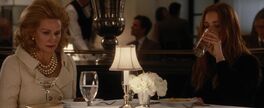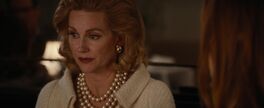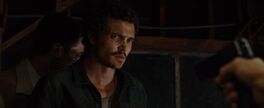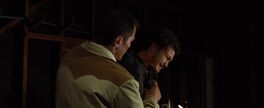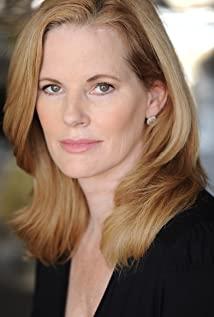01
Nocturnal Animals is a frightening film at first glance, and that intimidation stems from its sense of form.
After the trial of the debut novel "Single Man", we can see that director Tom Ford has accumulated a lot of film narrative experience, and has also mastered the relevant grammar of movies, gradually getting out of the state of "killing the old master with random fists" and becoming a More mainstream and sophisticated. This growth in ability is very evident in Nocturnal Animals.
The most striking thing in the film is the intertwined narrative structure of the triple text, which is also the main source of the film's sense of form. The first text is the text of the novel. This heavy text was born out of the novel "Nocturnal Animals" by author Edward. It tells the story of Tony's family being murdered in the suburbs of Texas late at night. Tony's wife and daughter were brutally raped and killed by gangsters. The surviving Tony and Sheriff Anders teamed up to chase the murderer, and finally met the murderer. The story of gangsters perishing together. The director pays the most attention to this heavy text, which is also the one with the most complete narrative, the strongest dramatic tension, and the most commercial elements in all the triple texts.
The second text is the recall text. The heavy text is rooted in the memory of the heroine Susan, who kept flashing past events with her ex-husband as she read the manuscript sent by her ex-husband. These past episodes include how the two met, how she resolutely married Edward despite her mother's obstruction, how she met her current husband, Mr. Morrow, how she left Edward and shed the child without him. This heavy text has less ink than the first heavy text, and mainly plays the role of explaining the history of the heroine Susan.
The third text is the actual text. This heavy text shows the life of the heroine Susan after leaving her ex-husband. In this heavy text we can see that Susan's married life was not complete. She has been married to her current husband for many years, and her passion has faded. Her husband Morrow is cheating, and her marriage relationship is in jeopardy. Mr. Morrow is also on the verge of bankruptcy, and his economic situation is not optimistic. This heavy text has very little ink, and there are not many ups and downs in the plot, like a panoramic display of the characters' living conditions.
In addition to the actor's face sharing, the three-fold texts are very different in time and space, story type, and image style. The director used more traditional transition methods, such as shots of similar tones (red), similar objects (email, fire), etc., to stitch the three lines more smoothly. And we were able to roughly guess the counterpoint relationship of the triple text.
Edward once said to Susan: "People only write about themselves and nothing else." This sentence is the key to unlocking the secret of the counterpoint relationship between the text of the novel and the text of memory.
Although the novel "Nocturnal Animals" tells a rough and bloody revenge story, the characters and plots appearing in it are symbolic and are Edward's psychological projections. For example, the mother and daughter who were brutally raped and murdered in the story, on the one hand, means Edward's self-blame and pain for his inability to save the unborn child, and on the other hand, his resentment and complaint about his ex-wife Susan's abortion. Another example is the group of outlaws led by Ray Marcus, who can be understood as the reasons for the collapse of Edward and Susan's love relationship. The external reasons include the resistance from Susan's family and the pressure from real life, and the internal reasons include Edward's inner wariness and estrangement about literary creation and the unknown future. The novel shows how Edward found these causes and eliminated them in a most heroic and tragic way. Tony, the protagonist of the novel, is the incarnation of Edward himself, and Tony's adventure is also the mental journey of how Edward resolved his pain and let go of his old feelings.
This precise alignment makes the text of the novel and the text of the memory closely linked, and the symbols in the previous text can almost always find their corresponding meanings in the next text.
Compared with the first two texts, the third text, the real text, is not very closely related to them. Although the film starts with a realistic text and ends with a realistic text, it is obviously not the focus of the director's narrative, and its narrative function is also very limited. It acts more like a soothing agent, allowing us to soothe the frequent jumping in and out of novels and memories, preventing us from indulging in Susan's personal feelings too much.
The interweaving of the three texts makes the narrative structure of the film seem quite complicated, and the audience also feels a strong sense of form under the not novel narrative tricks played by Tom Ford.
Aside from the triple-text narrative, the film's most talked-about opening is its opening: several overly bloated and obese naked women with fireworks in their hands, heavily makeup and dancing in front of the camera. A lump of vibrating fat exudes a strong sense of disgust, accompanied by a melodious and solemn symphony, bringing us a strange and deformed aesthetic experience. The three-minute-long opening bluntly conveys a Tom Ford-esque aesthetic: strong, sexy, and weird. We later learned that these fat women were nothing more than installations at Susan's gallery show, and they didn't appear again in the latter part of the film. But this shocking three minutes is enough to elevate the overall style of the film and stamp the author's unique and distinctive brand.
Tom Ford, who was born in the fashion circle, also has extremely high requirements for character modeling, scene design and photography.
The film is impressive in two places in the text of the novel. One was that Sheriff Anders took Tony and found the bodies of his wife and daughter in a garbage incinerator. The white bodies of the wife and daughter were facing each other, lying on a bright red couch. The two are calm and soft like sculptures, without any tragic and messy after being raped and murdered. The other is the Texas sky under Tom Ford's lens: the sun sets in the west, the clouds are burning, and the sky is dyed a rich pink, a very iconic natural beauty.
In the part of memories and realistic texts, Tom also tries to keep the background of the characters as pure as possible, using large areas of red, pure white, and black, and sometimes embellishing them with artworks. And the characters wear well-cut fashion all the time, with exquisite makeup.
The fireworks of the story are subtly eliminated, and the deliberately created sense of form alienates us from the film. The characters don't seem to be experiencing a flesh-and-blood story, but are shooting fashion blockbusters for the new issue of "VOGUE" magazine.
02
If form and content are likened to the two legs that support the film, Nocturnal Animals is almost on one leg. The liveliness in form reflects the emptiness and weakness in the content of the story.
The biggest problem with movies is the uneven distribution of content in the triple text. As a result, there is a lack of character creation.
As the highlight of the film, the director put a lot of effort into the text of the novel. Although the story of the murder that took place in the suburbs of Texas is not cleverly told, and even a bit cliché, the ins and outs of the story are explained very clearly, and we can clearly see the psychological transformation of a man - from a coward to a hero. Tony makes us empathize. We will not forget that at the end of the novel, the shocking image of the dying Tony using all his strength to sound the victory shot is a grand celebration of getting rid of the old self.
In the flashback text, the director tells an incomplete love tragedy. This incompleteness is reflected in the portrayal of Susan. Susan's mother once said to Susan, "We will all be our own mothers eventually." This sentence shrouded like a curse, until Susan and Edward's love went to ruin: when she came out, Susan fell in love with the penniless Edward at first sight. ; at the end, Susan sits in Mr. Morrow's luxury car, confessing to the child she killed. This is a very interesting psychological transformation. We are eager to see how a noble lady who originally believed that true love transcends everything will fulfill her mother's curse step by step, and eventually become the person she hates.
But Tom omits all of that, and all we see is the outcome: Susan arguing with her mother, Susan arguing with Edward, Susan and Edward breaking up. Susan's characterization is one-sided, and the story is fast-forward. We can't have empathy for her, she is just a symbol of "dislike the poor and love the rich" written by the director.
Susan's mother was also symbolized. She only appears once in the movie, playing an evil witch who unleashes a curse.
Real-life texts are more rapid in narrative. The director didn't even have the mind to tell the story, and was very happy with the various sighs, tears, and shock reactions of the actresses.
In order not to make this layer of text appear too bland, the director inserted three deliberate and clichéd stalks to create ups and downs.
The first is "scratch the finger". When Susan opened the new book sent by Edward, her fingers were cut by the paper, implying Edward's revenge, and Susan was about to face a dangerous spiritual journey. This is the director's "little cleverness", but unfortunately this cleverness is too easy to see through, so it turns into a funny public show.
The second is "elevator derailment". We can infer that Susan already knew about Mr. Morrow's infidelity. The director can express it in a more obscure and advanced way. And he chose to lie beside the audience's ears and advertise it loudly.
The third is "mobile phone scares". In this scene, the director deliberately zoomed in on the dark green screen of the phone, and then let Ray Marcus suddenly jump out to startle the audience. The purpose of doing this is to tell us that Susan is too addicted to reading. The frightening effect does meet expectations, but it also destroys the frigid atmosphere carefully crafted by the actual text.
The use of these stalks suitable for B-level horror films and vulgar romance films exposed the director's youthful and powerless narrative to a certain extent.
The only seriously portrayed character in Nocturnal Animals is the writer Edward, who never shows up from beginning to end. Through the mutual complementation of the fictional text and the realistic text, we see a fresh Edward, see his growth, enjoy his pleasures, and mourn his sorrows. And Susan is flat and functional. At first, she left the poor Edward because she disliked the poor and loved the rich, and now she wants to leave Mr. Morrow, who is on the verge of bankruptcy, and re-enter Edward's arms. In the film, her role is to guide us closer to the character of Edward. The director made the starting point and ending point of the story focus on Susan, which was a miscalculation.
In addition to Susan, characters such as Sheriff Anders, Susan's mother, and Ray Marcus are all symbolic, either righteous to the last moment of life, or evil to the last moment of life. Maybe such a person exists in real life, but in a drama, it is too monotonous.
03
Is Nocturnal Animals a story of revenge?
All the signals in the film seem to point to "revenge": Susan's finger was slashed when she received the novel, a painting with the word "REVENGE" hung on the museum wall, a bison specimen shot through by random arrows, the content of the novel makes Susan's mental world collapsed, Edward agreed to go to the appointment but released Susan's pigeon... At the end, Susan got the punishment she deserved. When she finally took off her disguise and prepared to meet a new relationship, she found that she had become a mockery of her ex-husband. Object.
From Susan's perspective, it was indeed a well-planned revenge.
From Edward's perspective, it was more like a well-planned farewell. In this way, he told Susan that he had let go of his old feelings and was ready to move on.
In the novel, Edward wrote his wife to death in a cruel way, but he also suffered great suffering in his heart. He overcame many obstacles and risked his life to avenge his wife and daughter in order to prove to Susan that he loved her dearly.
It's a pity that this love disappeared with the fight and death at the climax of the story. As Edward once said to Susan: "If you love someone, you will find a way to solve the problem, instead of blindly breaking up. You have to cherish love, because there may be no second time."
Edward has completed a journey of spiritual redemption through creation, and he is no longer cowardly and wary. This process of self-sublimation is painful and worthwhile. Learning how to love and learning how to let go of love are topics that all human beings should spend their entire lives studying.
From this point of view, the theme of "Nocturnal Animals" and "Single Man" are in the same vein.
Welcome to pay attention to the personal public account "iSeaCat", and update film reviews from time to time.
View more about Nocturnal Animals reviews



